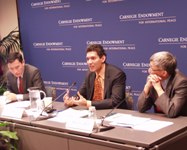Registration
You will receive an email confirming your registration.
IMGXYZ1032IMGZYXThe economic reforms that have lead to China's rapid GDP growth and poverty reduction turn 30 this year. The conventional wisdom of China’s growth – often called the “Beijing Consensus" – is that incremental privatization is the key to China's economic growth. Yasheng Huang spoke about the findings in his new book, Capitalism with Chinese Characteristics, in which he challenges that conventional understanding by revealing that rural privatization has actually slowed considerably over the last 15 years.
Huang, a professor at the Sloan School of Management at MIT, was joined by Eswar Prasad, senior fellow at the Brookings Institution, and Carnegie's Minxin Pei.
Getting the Facts Right
Yasheng Huang disputed some basic assumptions of the Beijing Consensus because they fly in the face of facts. He argued that the reforms in the 1980s were very far reaching and substantial for private sector development, especially in rural areas led by township and village enterprises (TVEs). In the 1990s, however, those reforms slowed, and privatization was rolled-back.
From 1978 to 1988, poverty in rural China declined by 154 million people, while it only declined by 62 million people from 1989 to 1999. Huang argued that the key to the greater success in the 1980s were TVEs, which were a focus of the early reforms of the 1980s. Out of 12 million TVEs existing in 1985, fully 10 million were totally private. Along with an abundance of government loans that were easily accessible to small businesses, this strategy created rapid poverty alleviation.
Urban Vs. Rural
In the 1990s a fundamental reversal was made in rural policy. First, there was a substantial increase in the qualifications enterprises needed for loans. Second, the government’s loan policy emphasized agricultural production instead of expanding rural entrepreneurship beyond agriculture. Farmers found it difficult to obtain money to start a non-agricultural business. Third, although most Chinese live in rural regions, a new focus was put on developing the urban regions. To pay for these urban reforms, the government heavily taxed rural citizens and reduced services in rural health and education. The result of these policy changes was a reversal that slowed down rural poverty alleviation and sharply increased the gap in urban-rural household income.
Though Huang made a strong case for widely varying economic policies in China between the 1990s and 1980s, his explanation for the reversal, he admitted, is not based on an exhaustive review of the facts. Nevertheless, he suspects that the reason is technocratic. In the 1980s, the Chinese Communist Party (CCP) was led by individuals who grew up in rural regions, while the leadership of the 1990s came from urban areas. Furthermore, this may explain why today’s CCP leaders, like rural-born Hu Jintao, are refocusing on rural reforms.
Questions & Answers
Eswar Prasad expressed his admiration for Huang’s provocative book as well as the importance of the work to understanding the reality of China’s growth. But Prasad also raised some questions about the book. For example, why was there so much growth in China during the 1990s despite the “reversal” in policy? This same issue was also raised by one of the audience members. In response, Huang clarified that he was only referring to a reversal in rural areas that increased inequality and decreased poverty alleviation. Certainly, he admitted, there was meaningful urban reform in the 1990s, but it came at the expense of the majority of Chinese citizens.
The question, going forward, is whether urban or rural economic growth should be given higher priority. Huang emphasizes the rural region, where people usually have an intuitive understanding of market principles. It seems as if today’s CCP is returning to some of the policies of the 1980s. They have already abolished the rural tax, reduced education and health fees, and revised rural finance.
But it may be too little, too late. In the midst of a global recession, a race exists that will determine the economic and – consequently – the political future of China. It is a race between declining U.S. consumption and China’s increasing rural income, which will drive Chinese consumption. As U.S. consumption sharply falls, China can only keep its growth rate high by replacing falling exports with increased consumption. And as experts frequently point out, China’s GDP is the paramount source of legitimacy for the CCP.
